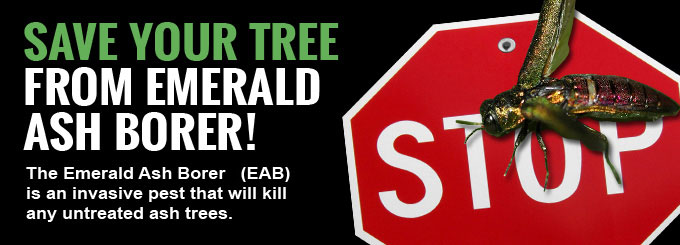
The Emerald Ash Borer has worked its way down to Kansas City. After devastating Ash trees in two provinces in Canada and 12 northern states, Missouri and Kansas are now falling victim to this very destructive insect. All Ash trees are in danger of dying if treatment is not administered.
Kansas City Metro Area Is Under Quarantine
Currently the entire state of Missouri, the Kansas City Metro Area, as well as Johnson County are all under quarantine regarding the Emerald Ash Borer. The quarantine regulates the movement of potentially-contaminated wood products including ash nursery stock, any part of an ash tree; including logs, green lumber, waste, compost, chips, etc., and firewood cut from any species of hardwood.
Most Recent Confirmed Infestations
1. Adult EAB insects were found in a trap set by the United States Department of Agriculture (USDA) in Johnson County, Kans., in the area of I-435 and Holliday Drive, on July 5, 2013.
2. Adult EAB insects have also been found in traps set by Kansas Department of Agriculture (KDA) in Wyandotte County, in the area of the first confirmed sighting in August of 2012.
3. The first confirmed sighting in Missouri was in Parkville in 2012
Without Proper Treatment, the Kansas City Area Is Likely to Lose Thousands of Ash Trees.
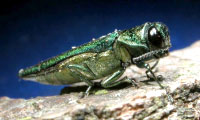 The bugs have become more pervasive in the last few years and we are starting to see the results. KC Arborist treated all of the street trees in Mission Hills and Fairway last summer and various apartment complex managers and homeowners associations have had us treat their properties as well. The key to stopping the Emerald Ash Borer is prevention. If you have Ash trees, or don’t know if you have Ash trees or not, call us for identification and an evaluation of your property.
The bugs have become more pervasive in the last few years and we are starting to see the results. KC Arborist treated all of the street trees in Mission Hills and Fairway last summer and various apartment complex managers and homeowners associations have had us treat their properties as well. The key to stopping the Emerald Ash Borer is prevention. If you have Ash trees, or don’t know if you have Ash trees or not, call us for identification and an evaluation of your property.
Signs the Emerald Ash Borer Is in Your Neighborhood
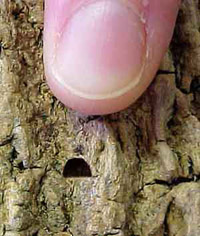 First, identify any Ash trees in your yard or neighborhood. There are several telltale signs all Ash trees have in common.
First, identify any Ash trees in your yard or neighborhood. There are several telltale signs all Ash trees have in common.
Branch Identification: Ash trees have branches that are directly across from one another, as opposed to staggered in height on the trunk
Leaf Identification: Ash trees have groups of leaflets that are joined by a stalk, as opposed to a single leaf joined by a stalk to the stem. Also, Ash tree leaflets have 5 to 9 leaves clumped together with smooth edges, as opposed to 3 to 5 leaves with jagged edges.
Infestation Identification: Once, you’re pretty sure your tree is an Ash, look for dieback in the upper canopy. If leaves aren’t forming on branches and the tree looks bare, you probably have the EAB. Also look for new sprouts forming around the base of the tree. Check the bark for D-shaped exit holes. Also, look for woodpecker damage as they like to eat the Emerald Ash Borer.
- Dieback in tree canopy
- New sprouts forming from the tree’s base
- “D” shaped exit holes
- Woodpecker damage

Don’t Wait – Prevention is the Key for Emerald Ash Borer
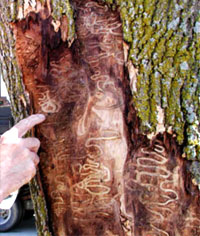 If you have Ash trees, call us for preventative treatment. “We knew an Emerald Ash Borer infestation in the Kansas City Metro Area was eminent,” says Jeff Sifrit, ISA & KAA Certified Arborist, President of K.C. Arborist Tree Care. “With this confirmation, it’s imperative that residents in the area with Ash trees understand that without proper treatment, these Ash tree will be lost.”
If you have Ash trees, call us for preventative treatment. “We knew an Emerald Ash Borer infestation in the Kansas City Metro Area was eminent,” says Jeff Sifrit, ISA & KAA Certified Arborist, President of K.C. Arborist Tree Care. “With this confirmation, it’s imperative that residents in the area with Ash trees understand that without proper treatment, these Ash tree will be lost.”
According to Jeff Sifrit, EAB disease prevention is the only option for Ash trees in the Kansas City Metro and surrounding areas. Once Ash trees are infected, they die within a few seasons without treatment. Specialty insecticides in effective concentrations are only available to licensed professionals. Jeff urges those with Ash trees to seek help from a certified arborist who can properly identify an Ash tree and provide a long-term treatment plan which includes follow-up.
K.C. Arborist Treatment Plan
K.C. Arborist Tree Care has been researching and developing an effective ash tree protection program since 2008, when the Emerald Ash Borer first threatened Missouri. Now the company is setting a proactive plan in motion to educate customers that local infestation is certain and treatment is the only way to stave off widespread devastation of Kansas City and surrounding ash trees.
In order to prevent your Ash tree from becoming infested, we recommend a preventative stem or soil injection, depending on the size of your tree. Trees less than 6″ in diameter may be treated annually with systemic insecticide injected into the soil. Trees greater than 6″ in diameter may be treated every two years with an insecticide injected directly into the trunk of your tree. This treatment combined with solid general tree care practices i.e. pruning, watering, and mulching will minimize risk of your Ash tree becoming infested.
Life Cycle of Emerald Ash Borer

A) The larvae live under the bark of the tree, feeding on the vascular cambium.
B) The larvae feeding leaves ‘galleries’ under the bark that interrupt nutrient flow to the canopy and eventually kill the tree.
C) The adult is a small, metallic green beetle only 10-15 mm in length. The adults typically emerge around June, leaving D-shaped exit holes in the bark. The adults feed briefly in the tree canopy before reproducing and laying eggs in the twigs and branches.
D) The larvae will start feeding in the branches at the top of the tree and work their way down. The first symptom in an infested tree is dieback in the tree canopy.
Ash Tree ID
E) Young Ash Tree – bark is relatively smooth
F) Mature Ash Tree – deep ridges form as the ash tree ages
G) Ash leaves typically have 5-9 leaflets per leaf, arranged directly opposite of each other.

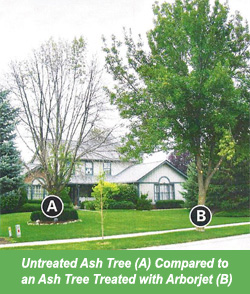 The Emerald Ash Borer (EAB) Outbreak has homeowners wondering what to do with their trees. Do I remove and replace, or ignore the problem altogether? If you remove the tree or ignore the problem, you end up with the same result . . . NO trees. If you treat the problem you end up with a healthy tree that will be on your property and increase your home’s value for years to come.
The Emerald Ash Borer (EAB) Outbreak has homeowners wondering what to do with their trees. Do I remove and replace, or ignore the problem altogether? If you remove the tree or ignore the problem, you end up with the same result . . . NO trees. If you treat the problem you end up with a healthy tree that will be on your property and increase your home’s value for years to come.
Why Does KC Arborist Use Arbor Jet’s Tree Injection Method?
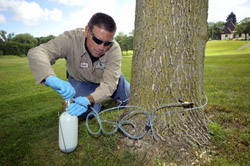
- Unlike spraying or soil drenching which put chemicals in the air and ground, KC Arborist’s injection puts all product inside the tree during application.
- We have up to 2 years proven control of EAB
- No other injection method has the proven results against EAB like we do.
Information courtesy of www.arborjet.com








